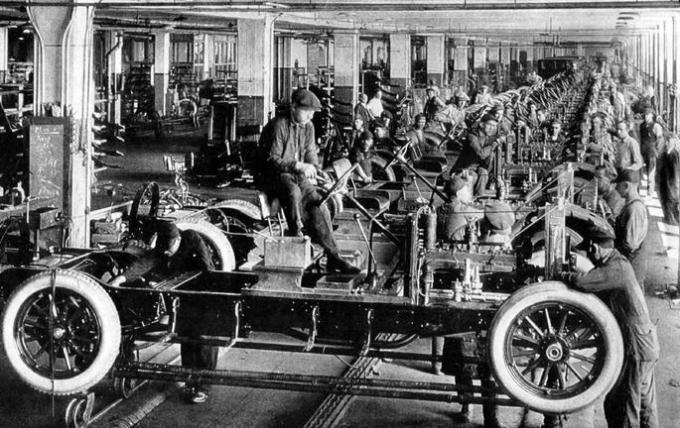O capitalist mode of production it is the way a productive system is organized with the aim of making a profit.
This system replaced the feudal mode of production in Europe and spread throughout the world in later centuries.
capitalist production
Throughout human history there have been several ways to produce goods, whether food, clothing or vehicles. We can mention the Asian, slave, feudal and capitalist mode of production.
The word capitalism comes from “capital”, that is, the money needed to start an enterprise.
The capitalist mode of production is profit-oriented. This is the result of the investment made by an entrepreneur, after the sale of their products or services.
In capitalism, the engine of productive and social relations is money. In order for this to circulate, capitalism transforms everything into merchandise, as these can be bought and sold in exchange for money.
In order to encourage people to buy and consume, capitalism ends up creating needs that don't exist, launching new products so that individuals can continue to spend their money.
With this mentality, everything that does not bring benefits is not used but discarded. On the other hand, what makes a profit is exploited.
Characteristics of capitalist production

Ownership in capitalist production
In the capitalist production system, property is private. This means that land, machinery, transport, real estate will belong to someone else.
To guarantee the validity of this property, a bureaucracy that guarantees the property rights to the individual or a company. This bureaucracy is represented by contracts, codes of law and professionals, which ensure the smooth operation.
One of the greatest theorists of the importance of property within the capitalist mode of production was the Englishman John Locke (1632-1704).
Labor relations in capitalist production
All work carried out within the capitalist mode of production is compensated with money.
Thus, there are occupations that are considered more important, because they are better paid, as they require more study time.
On the other hand, there are functions that do not receive as much money, because they are considered "minor" for the functioning of society. This will give rise to social classes.
Social classes in capitalist production
Society is also divided into groups that have been called "social classes" by the scholar Karl Marx. In fact, it was this thinker who best explained the workings of the capitalist mode of production.
According to Marx, there are two great social classes in capitalism. Those who have the goods of production, the bourgeois, and those who don't. Better said, they only have their children, your offspring. In this way, they were called “proletariat”.

As the proletariat has no means to produce goods, it sells its labor power to the bourgeoisie. In return, he receives a cash salary, which he will use to cover his needs.
The capitalist mode of production makes the worker not aware of his role in society. This phenomenon was called by Marx "alienation" and makes him just a spectator and not an active citizen.
Types of Capitalism
Capitalism is not understood by all governments and thinkers alike. Although their goal is the same - profit - the way to achieve it varied by time and country.
One of the characteristics that differentiate types of capitalism is the degree of state intervention. So we have liberalism, proposed by Adam Smith, which preaches that the State should not meddle in economic affairs, leaving this function to the market.
On the other hand, we have the theory elaborated by John Maynard Keynes (1883-1946), the Keynesianism, which defends the State's interference in the economy in order to ensure the well-being of the entire society.
opposition to capitalism
Likewise, there are people who do not agree with the capitalist mode of production.
In the nineteenth century, a number of social scientists tried to formulate alternatives to the capitalist mode of production. Thus, the anarchism, O communism and socialism that sought other ways of productive and social organization.
Origin and Stages of Capitalism
Capitalism emerged at the end of the 15th century and marked the end of the feudal mode of production. This replacement occurred slowly, but it reached all sectors of society, and it is called transition from feudalism to capitalism.
From Europe, capitalism passed to the colonies of America and Africa. There were extracted the riches that made the European continent strengthen and develop.
Thus, capitalism is divided into three major phases: mercantile capitalism, industrial capitalism and financial capitalism. Each stage is named after the most important economic activity of the moment: commerce, industry and financial transactions.
Want to know more? Toda Matéria has these texts for you:
- Mercantilism
- commercial capitalism
- Industrial Capitalism
- neoliberalism
- Industrial Revolution
